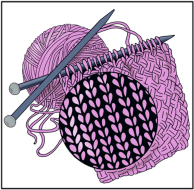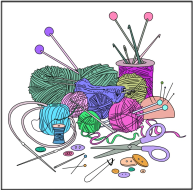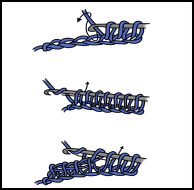

NEEDLE KNITTING
In this article, we provide more detailed information about the needle knitting technique and give you an idea of how to start your learning.
Needle knitting is rightfully one of the most preferred knitting techniques. According to some estimates, 60% of all knitters use needles. It is accounted for by immense possibilities provided by the knitting technique. Needles can be used to knit almost all kinds of articles which vary significantly in their appearance and size.
The use of this yarn and thin needles allows making lightweight, openwork and open things, garments that can be worn in summer, for example.
Using thick, textured yarn and corresponding needles, you can knit outwear (coats, jackets), warm wraps, etc.
Methods of creating fabric also provide a wide array of options. The knitted fabric is formed by four types of stitches: knits, purls, yarn overs, and chain stitches. These stitches can be crossed, united together, skipped or combined with each other. This is how you can create an infinite number of patterns which predetermine the fabric look and geometry (any part of fabric can be widened, narrowed, rounded, etc.). It should be noted that knits and purls are the stitches that form the material. Yarn overs and chain stitches are auxiliary stitches, and you cannot make a fabric using yarn overs or chain stitches only, they have to be combined with knits or purls.
When you start learning to knit, the following techniques should be mastered:
- Cast-on: There are a lot of ways to cast on stitches. The choice of the method depends on what properties the fabric is to have. In most cases, it is horizontal stretchability. There are cast-on methods which allow creating an elastic, stretchable lower edge of the article. The second group comprises means used to obtain a practically non-stretchable side. The third group includes cast-on methods which provide for a border with a medium elasticity.
- Making the knit stitches.
- Knitting the purls stitches.
- Creating yarn overs. There are two types of yarn overs: forward and backward ones. Besides, they can be single or double. Yarn overs are used to make holes (openwork elements) in the fabric or for a local extension.
- Creating chain stitches. Chain stitches can be used to provide an extension in any part of the fabric. As a rule, it is done on one of the fabric sides to extend it.
-
Increasing and Decreasing Stitches. If you want to change the width of your knitting, you will need to learn how to increase and decrease stitches. This will allow you to make more interesting knitted shapes. When you increase stitches, you are adding an extra stitch (or loop) to your needle. This will increase the length of your row by one stitch, thus increasing the width. When you decrease stitches, you are removing a stitch (or loop) from your needle. This will shrink the length of your row by one stitch, thus decreasing the width.
- Cast off (Bind off). As with cast on, there are many ways to close stitches. Different methods provide different properties (elasticity, thickness) of the edge of a knitted fabric.
You can learn about these techniques here: LINK
Then, to master the knitting technique, we recommend knitting small fabrics – swatches consisting of only knits (garter stitch pattern), only purls (reverse stockinette stitch pattern) or a combination of knits and purls (stockinette stitch pattern). Try to make yarn overs and chain stitches in some rows of the fabric. This way you will see the differences in structures obtained and understand how the process of knitting takes place.
What limitations are there when knitting with needles? The main weakness is the needle length and, consequently, the width of the knitted fabric. When any row is completed, all stitches of the material are on the same needle. It is the number of stitches a needle can hold that limits the fabric width. This problem is partially solved by using needles with rather long cables as well as those with detachable cables which can be extended. However, when a substantial fabric becomes long enough, it is hard to work with as its weight applies to the needles, even if some stitches are on the cable, and the knitter’s hands experience heavy load. Of course, this restriction refers to very wide fabrics such as wraps or covers. But you should remember about it if you are going to knit an extensive article. As for clothes, almost any size garment can be knitted using standard size needles without any particular inconvenience.
Back-and-forth and circular knitting are worth special mentioning.
Back-and-forth knitting: after all stitches in a row have been knitted, the work is turned to the other side (back) so that the last stitch of the previous row becomes the first stitch of the following row. The fabric has two edges. These edges are used to join (sew) pieces together if there are several of them in the article.
Circular knitting: when the first row is knitted, it is closed into a circle (the first and the last stitches of the row are united together). All needles connected to each other with a flexible cable or a set of 5 double-pointed needles can be used for circular knitting. All stitches are uniformly placed on four needles and closed into a circle while the fifth needle is used as a working one. The working needle constantly alters because new stitches are moved onto it while the emptied needle becomes the working one.
Straight needles with knobs at their ends cannot be used for circular knitting because they do not allow closing a row of stitches into a circle.
After a row is closed into a circle, stitches are knitted again and again so that the fabric is formed spirally and you always work on the same side of the material without turning it. To know the number of knitted rows, it is recommended to use a particular marker. As a rule, it is a small ring which is fitted onto a needle after the first row is closed into a circle. The scorer is between the first and the last stitches of the row and is shifted during knitting. When you reach the marker, you know that you have completed another row. The number of knitted rows, both during back-and-forth and circular knitting can be noted using another tool – rows counter. Our website has service "Online knitting". Here you can track row number all your patterns. Information about the row number will be saved in the "My projects" section of your account.
Circular knitting is used to form seamless articles. All pieces are formed one by one or simultaneously as a single fabric.
Circular knitting is very convenient for making small articles such as hats, socks or mittens though large garments such as pullovers, trousers or skirts can also be knitted in the circle.
Beginners are recommended to start knitting their first articles using the back-and-forth knitting technique. It makes it easier to monitor the size of the article/piece as well as find and correct any mistakes.
Have a nice trip to the world of knitting!

